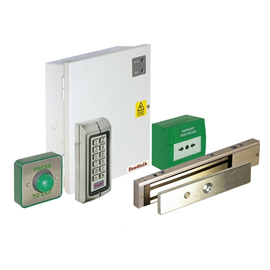Tuesday 2nd July 2024
Securing your building against unauthorized entry whilst maintaining a swift and safe fire escape can be challenging. Magnetic locks (also known as maglocks) are designed for this purpose, to provide secure access control into a building.

How do magnetic door locks work?
Maglocks use a strong, electrically powered electromagnet to hold the door closed. If the power fails, or is interrupted by a fire alarm signal, the magnet loses power and releases the door. During normal use, the door is released by pressing an INSIDE button, with external keypad overrides available.
Magnetic lock kits
Magnetic door lock kits can include the following release methods:
- Key fobs
- Card reader units
- Release switches
- Digital keypads
- Emergency break-glass units
Of course, if the fire alarm is activated, the maglocks will be released automatically in any system. The maglock devices are powered by a 12V power supply.
We have a range of magnetic access control kits that keep out uninvited guests. Linking up with fire detection units and releasing doors in the event of a fire. These kits also come ready to be installed by a qualified electrician.
For a range of other access door control equipment, take a look at our exit door security range.
To find out more about magnetic locks, contact our customer service team at 0800 612 6537 or email customeraccounts@safelincs.co.uk.
